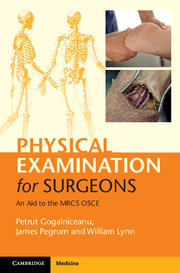Book contents
- Frontmatter
- Dedication
- Contents
- List of contributors
- Introduction
- Acknowledgments
- List of abbreviations
- Section 1 Principles of surgery
- Section 2 General surgery
- Section 3 Breast surgery
- Section 4 Pelvis and perineum
- Section 5 Orthopaedic surgery
- Section 6 Vascular surgery
- Section 7 Heart and thorax
- 30 Examination of the thorax and lungs
- 31 Examination of the heart and great vessels
- Section 8 Head and neck surgery
- Section 9 Neurosurgery
- Section 10 Plastic surgery
- Section 11 Surgical radiology
- Section 12 Airway, trauma and critical care
- Index
30 - Examination of the thorax and lungs
from Section 7 - Heart and thorax
Published online by Cambridge University Press: 05 July 2015
- Frontmatter
- Dedication
- Contents
- List of contributors
- Introduction
- Acknowledgments
- List of abbreviations
- Section 1 Principles of surgery
- Section 2 General surgery
- Section 3 Breast surgery
- Section 4 Pelvis and perineum
- Section 5 Orthopaedic surgery
- Section 6 Vascular surgery
- Section 7 Heart and thorax
- 30 Examination of the thorax and lungs
- 31 Examination of the heart and great vessels
- Section 8 Head and neck surgery
- Section 9 Neurosurgery
- Section 10 Plastic surgery
- Section 11 Surgical radiology
- Section 12 Airway, trauma and critical care
- Index
Summary
Checklist
WIPER
• Patient sitting on edge of examination couch with all clothing above the waist removed
Physiological parameters
General
• End of bed: shortness of breath, wheeze
• Bedside: sputum pot, bedside oxygen, cigarettes, inhalers
• Hands: nicotine staining and finger clubbing
• Face: Horner's syndrome (ptosis and meiosis) and venous engorgement of head and neck veins
Inspection
• Neck: lymphadenopathy, low transverse cervical scar for mediastinoscopy, tracheostomy scar, tuberculous abscesses
• Chest wall deformities: pectus excavatum (pushed in) or pectus carinatum (pushed out)
• Chest movement: asymmetry of expansion, contraction of one side of the chest wall, paradoxical movement (flail chest)
• Scars: midline sternotomy, lateral/posterior/posterolateral thoracotomy, small scars (video-assisted thorascopic surgery or chest drains)
• Radiotherapy tattoos
• Chest drains
Palpation
• Neck: lymphadenopathy, goitre, position of trachea
• Chest: sternal tenderness or instability, rib tenderness, asymmetry of expansion
Percussion
• Chest wall: resonant, dull or hyper-resonant
Auscultation
• Chest wall: breath sounds (vesicular, crackles, wheeze, reduced air entry)
To complete the examination…
• Bedside spirometry
• Chest x-ray
Examination notes
What are the basic thoracic and pulmonary symptoms?
The main symptoms of thoracic disease are shortness of breath, fatigue, wheeze, stridor, cough, sputum production, haemoptysis, chest pain and voice hoarseness.
How do you prepare for the examination of the thorax?
The patient needs to be sitting on the edge of the examination couch, exposed from the waist up.
What do you look for during inspection?
• Start the examination by inspecting the hands. Look for nicotine stains from cigarette smoking (risk factor for lung malignancy) and finger clubbing (a possible sign of malignancy or chronic lung disease).
• Move up to the face, looking at the eyes for evidence of ptosis (drooping of the eyelid) and meiosis (a constricted pupil), which are signs of Horner's syndrome. This may be caused by a Pancoast's tumour originating from the superior sulcus of the lung.
- Type
- Chapter
- Information
- Physical Examination for SurgeonsAn Aid to the MRCS OSCE, pp. 255 - 263Publisher: Cambridge University PressPrint publication year: 2015



